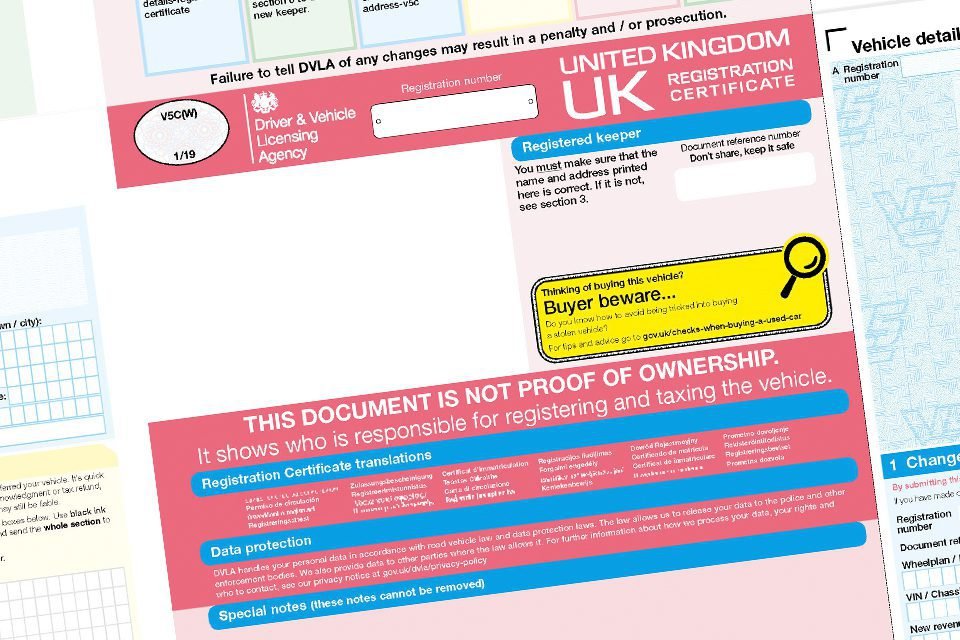Compare cheap car insurance
✔ Compare cheap car insurance quotes
✔ Over 110 insurance providers
✔ Get a quote in minutes
✔ Save up to £504*
Are you unsure about the year of your car and need to find out its age for reasons like getting an insurance quote, selling the vehicle, or purchasing specific parts? Our detailed guide will help you identify the exact year of manufacture of your car.
How Can I Find Out What Year My Car Is?
Discovering the year of your car is straightforward if you know where to look. The number plate on your vehicle holds the key to this information, blending letters and numbers to indicate not just the car’s age but also the location of its initial registration.
Checking the Number Plate
The most efficient way to ascertain your car’s year is by examining its number plate. This plate features a unique combination of letters and numbers that reveal significant details about the vehicle, including its manufacture and registration year.
Why Knowing Your Car’s Year Matters
Understanding the year your car was made is crucial for several reasons. It’s essential when arranging car insurance, buying specific parts, or if you’re contemplating selling your vehicle. By decoding the number plate, you can quickly and easily determine the manufacture and registration date of your car.


How much can you save on your car insurance?
Current Number Plate Series
The number plate system in the UK underwent a significant change with the introduction of the “Millennium registration” in 2001. This system, still in use today, incorporates a specific format that reveals crucial details about a car’s origin and age.
Understanding the Format
The Millennium plates follow a structured format that includes both letters and numbers, each segment providing different information about the vehicle.
Local Memory Tag
The first part of the number plate consists of 2 letters known as the local memory tag. These letters are crucial as they indicate the area where the car was initially registered.
Specifically, the first letter correlates with a postcode area, and the second letter identifies the DVLA office that handled the car’s registration.
Age Identifier
Following the local memory tag are 2 numbers that serve as the age identifier. These numbers reveal not only the year of registration but also the six-month period within which the car was registered, distinguishing between March to August and September to February.
Random Letters
The number plate concludes with 3 random letters, adding a unique identity to each vehicle. This combination ensures that each car’s number plate is distinctive.
The Significance of Decoding Your Number Plate
By decoding the number plate, you can easily determine your vehicle’s registration year and location. This information is particularly useful for various reasons, including arranging car insurance, acquiring specific car parts, or if you are considering selling your car.
How much can you save on your car insurance?
How Old Is My Car?
In the UK, number plates are formatted in a way that tells you both the age and origin of a vehicle. Since 2001, the “Millennium registration” system has been in place, enabling car owners to decode their number plates to find out when their car was registered and its initial registration location.


Deciphering the Number Plate
The Millennium number plate format includes several elements that reveal important information about your car.
Local Memory Tag
The first two letters on the number plate are known as the local memory tag. This tag indicates the area where your car was first registered.
The first letter matches a specific postcode area, and the second letter identifies the DVLA office responsible for the car’s registration. Below is a brief overview of what these letters represent:
| Code | Region |
|---|---|
| A | Anglia (Norfolk, Suffolk) |
| B | Birmingham, Black Country |
| C | Wales (Cardiff) |
| D | Deeside, Shrewsbury, Chester |
| E | Essex |
| F | Forest and Fens (Peterborough, Lincolnshire) |
| G | Garden of England (Kent, East Sussex) |
| H | Hampshire, Dorset, Isle of Wight |
| J | South East (London, Surrey) |
| K | No official region |
| L | Liverpool, Lancashire |
| M | Manchester |
| N | North |
| O | Oxford, Oxfordshire |
| P | Preston, Cumbria |
| R | Reading, Bournemouth |
| S | Scotland |
| V | Severn Valley (Worcestershire, Gloucestershire) |
| W | West of England (Bristol, Somerset) |
| X | No official region |
| Y | Yorkshire |
Age Identifier
The age identifier, represented by the middle two numbers on the plate, tells you the year of registration and the six-month period within which the car was registered.
This system allows for a precise identification of the car’s age, with codes that range from 51 (September 2001 – February 2002) to 99 (September 2049 – February 2050), showing a clear progression over the years.
| Code | Registration Year |
|---|---|
| 51 | September 2001 – February 2002 |
| 02 | March 2002 – August 2002 |
| 52 | September 2002 – February 2003 |
| 03 | March 2003 – August 2003 |
| 53 | September 2003 – February 2004 |
| 04 | March 2004 – August 2004 |
| 54 | September 2004 – February 2005 |
| 05 | March 2005 – August 2005 |
| 55 | September 2005 – February 2006 |
| 06 | March 2006 – August 2006 |
| 56 | September 2006 – February 2007 |
| 07 | March 2007 – August 2007 |
| 57 | September 2007 – February 2008 |
| 08 | March 2008 – August 2008 |
| 58 | September 2008 – February 2009 |
| 09 | March 2009 – August 2009 |
| 59 | September 2009 – February 2010 |
| 10 | March 2010 – August 2010 |
| 60 | September 2010 – February 2011 |
| 11 | March 2011 – August 2011 |
| 61 | September 2011 – February 2012 |
| 12 | March 2012 – August 2012 |
| 62 | September 2012 – February 2013 |
| 13 | March 2013 – August 2013 |
| 63 | September 2013 – February 2014 |
| 14 | March 2014 – August 2014 |
| 64 | September 2014 – February 2015 |
| 15 | March 2015 – August 2015 |
| 65 | September 2015 – February 2016 |
| 16 | March 2016 – August 2016 |
| 66 | September 2016 – February 2017 |
| 17 | March 2017 – August 2017 |
| 67 | September 2017 – February 2018 |
| 18 | March 2018 – August 2018 |
| 68 | September 2018 – February 2019 |
| 19 | March 2019 – August 2019 |
| 69 | September 2019 – February 2020 |
| 20 | March 2020 – August 2020 |
| 70 | September 2020 – February 2021 |
| 21 | March 2021 – August 2021 |
| 71 | September 2021 – February 2022 |
| 22 | March 2022 – August 2022 |
| 72 | September 2022 – February 2023 |
| 23 | March 2023 – August 2023 |
| 73 | September 2023 – February 2024 |
| 24 | March 2024 – August 2024 |
| 74 | September 2024 – February 2025 |
| 25 | March 2025 – August 2025 |
| 75 | September 2025 – February 2026 |
| 26 | March 2026 – August 2026 |
| 76 | September 2026 – February 2027 |
| 27 | March 2027 – August 2027 |
| 77 | September 2027 – February 2028 |
| 28 | March 2028 – August 2028 |
| 78 | September 2028 – February 2029 |
| 29 | March 2029 – August 2029 |
| 79 | September 2029 – February 2030 |
| 30 | March 2030 – August 2030 |
| 80 | September 2030 – February 2031 |
| 31 | March 2031 – August 2031 |
| 81 | September 2031 – February 2032 |
| 32 | March 2032 – August 2032 |
| 82 | September 2032 – February 2033 |
| 33 | March 2033 – August 2033 |
| 83 | September 2033 – February 2034 |
| 34 | March 2034 – August 2034 |
| 84 | September 2034 – February 2035 |
| 35 | March 2035 – August 2035 |
| 85 | September 2035 – February 2036 |
| 36 | March 2036 – August 2036 |
| 86 | September 2036 – February 2037 |
| 37 | March 2037 – August 2037 |
| 87 | September 2037 – February 2038 |
| 38 | March 2038 – August 2038 |
| 88 | September 2038 – February 2039 |
| 39 | March 2039 – August 2039 |
| 89 | September 2039 – February 2040 |
| 40 | March 2040 – August 2040 |
| 90 | September 2040 – February 2041 |
| 41 | March 2041 – August 2041 |
| 91 | September 2041 – February 2042 |
| 42 | March 2042 – August 2042 |
| 92 | September 2042 – February 2043 |
| 43 | March 2043 – August 2043 |
| 93 | September 2043 – February 2044 |
| 44 | March 2044 – August 2044 |
| 94 | September 2044 – February 2045 |
| 45 | March 2045 – August 2045 |
| 95 | September 2045 – February 2046 |
| 46 | March 2046 – August 2046 |
| 96 | September 2046 – February 2047 |
| 47 | March 2047 – August 2047 |
| 97 | September 2047 – February 2048 |
| 48 | March 2048 – August 2048 |
| 98 | September 2048 – February 2049 |
| 49 | March 2049 – August 2049 |
| 99 | September 2049 – February 2050 |
The Importance of Knowing Your Car’s Age
With the number plate format, you can swiftly pinpoint the registration year of your car, providing valuable insights into its age and origin.
This information is crucial for several reasons, such as securing insurance, sourcing specific car parts, or if you’re considering selling your vehicle.
Understanding the age and origin of your car can greatly aid in these processes, making the Millennium registration system a key tool for car owners in the UK.
How much can you save on your car insurance?
Find Out the Year of a Pre-2001 Car
For cars registered in the UK before 1 September 2001, two distinct registration formats—suffix and prefix—reveal the vehicle’s initial registration year. Here’s a guide to understanding how to determine the age of a pre-2001 car.
Suffix Registration Format (1963 – 1982)
Cars registered from 1963 to 1982 employed the suffix registration format, which is arranged as follows:
- Three letters (area code)
- Random numbers
- One letter (age identifier) denoting the registration year
This format’s age identifier appears at the end of the registration number, directly indicating the car’s registration year. The identifiers range from A (1963) to Y (1982), with each letter representing a different year.
| Age Identifier | Suffix Registration Year |
|---|---|
| A | 1963 |
| B | 1964 |
| C | 1965 |
| D | 1966 |
| E | 1967 |
| F | 1967 |
| G | 1968 |
| H | 1969 |
| J | 1970 |
| K | 1971 |
| L | 1972 |
| M | 1973 |
| N | 1974 |
| P | 1975 |
| R | 1976 |
| S | 1977 |
| T | 1978 |
| V | 1979 |
| W | 1980 |
| X | 1981 |
| Y | 1982 |
Prefix Registration Format (1983 – 1 September 2001)
For cars registered between 1983 and 1 September 2001, the prefix registration format was used. This format includes:
- One letter (age identifier) for the year of registration
- Random numbers
- Three letters (area code)
In this system, the age identifier precedes the number and area code, with each letter from A (1983) to Y (2001), excluding certain letters, representing a specific registration year.
By consulting the age identifiers in these formats, you can quickly ascertain a pre-2001 car’s approximate year of manufacture.
This information is particularly useful for historical interest, vehicle valuation, or sourcing specific parts for older cars.
| Age Identifier | Prefix Registration Year |
|---|---|
| A | 1983 |
| B | 1984 |
| C | 1985 |
| D | 1986 |
| E | 1987 |
| F | 1988 |
| G | 1989 |
| H | 1990 |
| J | 1991 |
| K | 1992 |
| L | 1993 |
| M | 1994 |
| N | 1995 |
| P | 1996 |
| R | 1997 |
| S | 1998 |
| T | 1999 |
| V | 1999 |
| W | 2000 |
| X | 2000 |
| Y | 2001 |
How much can you save on your car insurance?
Understanding Exclusions in Suffix and Prefix Registration Formats
The suffix and prefix registration formats used in the UK before 2001 incorporated a thoughtful approach to ensure clarity and readability of number plates. Certain letters were deliberately omitted to avoid confusion with numbers or other characters.
Letters Omitted and Why
I and O
The letters I and O were not used in these registration formats. The reason is straightforward: to prevent any confusion with the numbers 1 and 0.
Given their similar appearances, including these letters could lead to misinterpretation or errors when reading the registration plates.
U and Z
Similarly, the letters U and Z were excluded. The U was left out because of its resemblance to the V, which is used in registration plates.
The Z was avoided to prevent confusion with the S, ensuring that the plates remained easy to read and distinguish.
Special Category: Q Plates
An interesting aspect of the UK’s vehicle registration system is the use of Q plates. These are designated for vehicles whose age is either indeterminable or does not fit within the standard registration formats.
This category typically includes kit cars, classic cars, and imported vehicles. The Q signifies that the vehicle’s age is unknown or cannot be identified.
By grasping these details, one can better understand the meticulous planning and precision that underpin the creation and assignment of vehicle registration plates in the United Kingdom.
This system not only aids in vehicle identification but also ensures a high level of consistency and legibility across the board.
How much can you save on your car insurance?
Other Ways to Check the Age of Your Car
If decoding your number plate feels too cumbersome, there are several alternative methods to ascertain your vehicle’s age without the hassle.
Check Your V5C Logbook
Your car’s V5C logbook is a treasure trove of information, prominently featuring the date of first registration.
Beyond this, the logbook details the current registered keeper, MOT history, service records, and tax information. For the initial registration date, simply look into the “Vehicle Details” section of your V5C logbook.


Access Information from the DVLA
The Driver and Vehicle Licensing Agency (DVLA) website is another valuable resource for vehicle information.
By navigating their online portal, you can uncover a wide range of details including the registration date, CO2 emissions, tax status, and MOT history.
You’ll need the vehicle’s registration number as well as its make and model to access this information.
Consult a Vehicle History Check Service
For a more comprehensive overview of your car’s history, consider using an online vehicle history check service.
These services offer extensive data covering aspects like the registration date, previous owners, mileage records, accident history, and much more. It’s an efficient method to obtain a detailed background of your vehicle.
Leveraging these methods, you can effortlessly find out your car’s age and explore a wealth of related information.
Whether through the V5C logbook, the DVLA website, or an external vehicle history check service, these avenues provide precise and dependable data regarding your vehicle.
How much can you save on your car insurance?
Frequently asked questions
Occasionally, the registration year of a car may not match its year of manufacture. The number plate, also known as the Vehicle Registration Mark (VRM), shows when a vehicle was initially registered.
On the other hand, the year of manufacture is detailed in the V5C logbook and can also be discovered by examining the VIN number.
To find out the age of most UK vehicles, simply look at the registration plate. But, be aware that some plates, such as personalised, ‘Q’, and Northern Irish plates, do not contain dates. If you encounter such plates, the vehicle’s age can be verified by looking in the V5C logbook or by using a Car Year Checker tool.
Per DVLA rules, you’re not allowed to attach a number plate to a car that would make it seem younger than it actually is.
For example, it’s prohibited to use a plate with the number ‘19’ on a car manufactured in 2011. Additionally, the DVLA strictly disallows the use of personalised plates on Q-plated cars.
The earliest UK number plates, which were issued from 1903 to 1963, were dateless. This meant that it was impossible to ascertain a vehicle’s age without specific knowledge.
Number plates issued after this period include ‘age identifiers’, which make it possible to immediately identify the age of a vehicle.
Before 2001, the system for number plates in the UK included prefix number plates (1983-2001) where the age identifier, indicating the registration year, was the first letter of the plate.
During the era of suffix plates (1963-1983), the age identifier was positioned as the last letter on the plate. Number plates issued before these periods did not have any age identifiers at all.
Northern Irish number plates feature a serial letter and county code, which indicate where the vehicle was registered, alongside a number sequence that can be up to four digits long.
However, these plates are dateless, so to find out the year of the vehicle, you’ll need to consult the V5C logbook, VIN number, or use a Car Year Checker tool.
If your car comes with a standard (new, suffix, or prefix-style) number plate, it’s unlikely to influence the valuation of your car.
On the other hand, dateless number plates are frequently coveted, meaning the more desirable your registration number is, the higher the potential boost to your car’s value.










